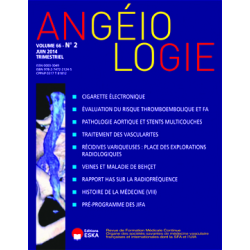


Article : Which venous thromboses in Behçet’s disease ?
W. Ammouri, Z. Tazi Mezalek
Service médecine interne – Hopital Ibn Sina – Rabat - Maroc
Faculté de médecine et de pharmacie – Université Mohamed V – Rabat – Maroc
Abstract
Behçet’s disease (BD) is a systemic affection with unclear cause and pathogenesis. The disease is characterized by great clinics polymorphisms with a particular frequency of the dermatological manifestations which account for three of the four criteria of the disease’s classification adopted by the International Study Group (ISG) (table 1). Vascular involvement, called also, « angio-Behçet » or « vasculo-Behçet » is particular because, it’s observed in young men without thrombotic or cardiovascular risk factors. All the vessels, arterial or venous, whatever their localization can be affected, with often, multifocal vascular manifestations. Vascular involvement is a severe disease, regarding the vital prognosis; it justifies a fast and aggressive therapeutic management.
Venous involvement recovers 80 to 90% of the vascular manifestations; it is found in a third of the patients. It is described at all the ages, and occurs in more half of the cases during the first five years of the evolution of the disease. This manifestation can precede or can be the mode of entry in the disease in meadows of 10% of the cases. Deep venous thrombosis of the legs is the most prevalent and represents 60 to 70% of venous localizations of the disease. It is often bilateral. Superficial venous thrombosis is also frequent and is mostly confused with an erythema nodosum. The involvement of large venous vessels is prevalent. Veina cava thrombosis is the second localization of the venous involvement during BD and represents nearly a quarter of the thrombotic manifestations. Budd-Chiari syndrome and/or portal thrombosis are associated with bad prognosis. Cerebral venous thrombosis are reported in 5 to 10% of BD. Intracardiac thrombosis are extremely rare but are recognized like a classical complication of the BD. Venous thrombosis during BD have a less embolic character than the idiopathic thrombophlebitis, because of wall inflammatory phenomenon who makes the thrombus more adherent. However, pulmonary embolisms are reported in 10 to 15% of cases and are associated with pulmonary artery anevrysms or with right intracardial thrombosis.
Therapeutic management of this manifestation does not rise from randomized or comparative studies. They are generally retrospective and observational studies. It gets clear however clearly that these cases of thrombosis must profit from a treatment aiming to reduce the wall inflammation. Corticosteroids and immunosuppressant allows reducing quickly the clinical symptoms and recurrences. Anticoagulation therapy is usually proposed but the benefit of this treatment is not demonstrated and the recent EULAR guidelines of the management of BD do not recommend the systematic use of anticoagulants in these cases.